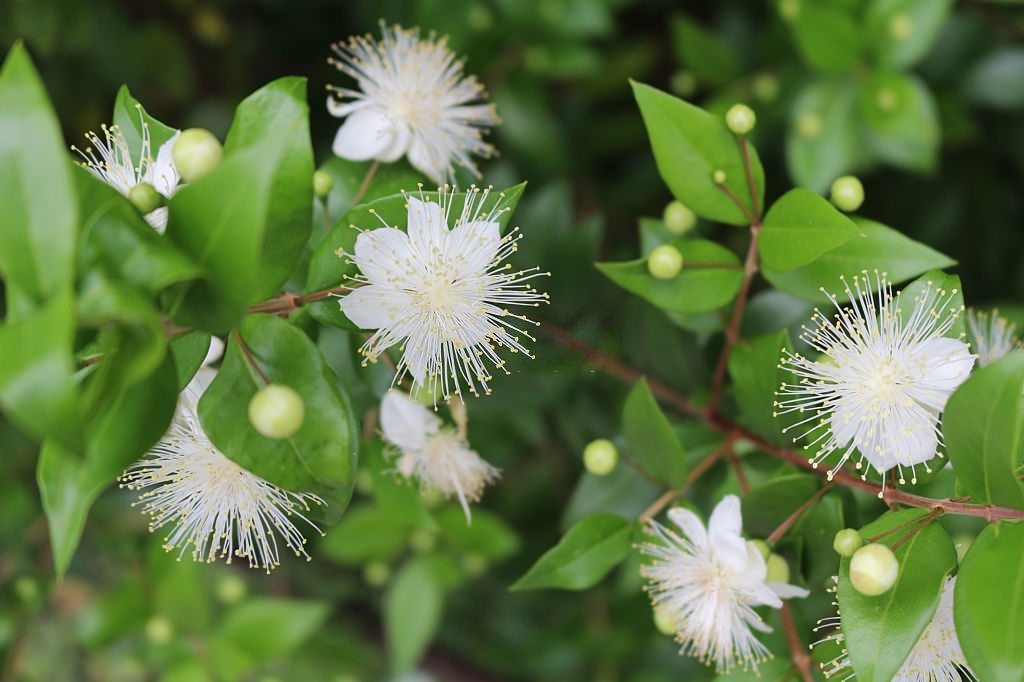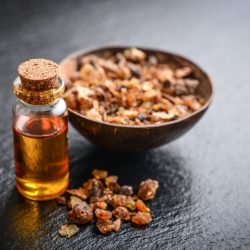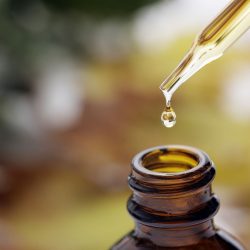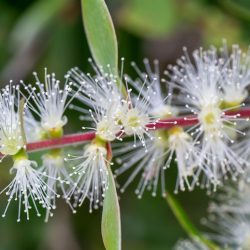Myrtle, whose botanical name is Myrtus communis L., belongs to the Myrtaceae family. The productive organs are the twigs.
Red myrtle (Myrtus communis var. tarentina) is an emblematic Mediterranean plant with exceptional aromatic and therapeutic properties. Among the olfactory and therapeutic treasures on offer in the world of essential oils, red myrtle essential oil occupies a special place. In this article, we’ll explore the different facets of this essential oil, from its chemical composition to its health benefits and uses in aromatherapy.
History of Myrtle
A little mythology
Sometimes dedicated to Artemis, sometimes to Hades, Mars or even Dionysus, the rich mythology of Greek civilisation tells us about the plant origin of the myrtle. Born of a quarrel between Athena and the nymph Myrsiné, who boasted of being able to beat the goddess in a race, Athena transformed the latter into a myrtle out of jealousy.
Among the Greeks, sometimes dedicated to Artemis, sometimes to Hades, when it’s not Mars or Dionysus, the rich mythology of this civilisation tells us about the phytogenesis of the myrtle: it was born after an incident between Athena and the nymph Myrsiné, who boasted of being able to beat the goddess in a race. And so it proved. Out of jealousy, Athena punished Myrsiné by turning her into a myrtle, which is rather strange, to say the least. Athena may be the ideal embodiment of wisdom, but we sometimes see her adopt typically human traits in the words of poets (and she is not the only figure in the classical Greek pantheon to be affected by this phenomenon). But what we remember above all is the close interrelationship between myrtle and the goddess of youth and beauty, Aphrodite.
Aware of the shame of her nakedness, Aphrodite took refuge behind a myrtle bush, which from then on became one of the many attributes, along with the quince and the rose, to adorn her chariot and accompany her in pictorial representations. It is said – by Ovid in The Fastes – that it was while seeking refuge from the concupiscence of the satyrs thatAphrodite found shelter in the bushy branches of a myrtle, which reverses the symbolism of the goddess and the myrtle, especially when we see her fleeing like a frightened virgin, when her preferred prerogatives are above all seduction and love, even if it is true that virginity is sometimes part of the package, as can be seen in Greece as well as in Eastern Europe.
Myrtle is also associated with Dionysus and the Underworld. When Dionysus descended into the Underworld to ask Hades to release his mother, Hades asked him for something that was very important to him. And the god gives up the myrtle. As a reminder, those initiated into the mysteries of Dionysus crown their foreheads with myrtle.
A little history
Myrtle was very important to most of the peoples and civilisations along the southern coast, growing wild in Corsica, Italy, the Maghreb, Egypt, the Balkans and elsewhere. Indeed, it has maintained a symbiotic relationship with the homelands of peoples such as Persia, Egypt and Greece. Hippocrates recommended bathing with myrtle to stop the flow of menstrual blood in women, while Theophrastus favoured Egyptian myrtle, which he claimed was milder.
Pliny noted that myrtle had digestive, antiperspirant and astringent properties, particularly in cases of diarrhoea, leucorrhoea and bleeding. The Greeks and Romans used myrtle for lung and urinary tract ailments.
In the 16th century, “angel water” was used in cosmetic lotions as an astringent tonic. Myrtle is used in cosmetology for its cleansing and toning properties, particularly in anti-dandruff shampoos. Myrtle was widely used in ancient Greece and Rome.
In popular medicine, myrtle is reputed to relieve haemorrhoids, leucorrhoea and lung ailments. The leaves are traditionally taken as an astringent and digestive tea to treat diarrhoea. The fruit is antiseptic and stimulates the capillaries.
The leaves and fruit are highly prized in cooking. In Corsica and Sardinia, Myrtle liqueur is made from the berries.
Tradition has it that myrtle guarantees eternal youth if planted by a woman. For Persians, Greeks and Romans alike, it was a sacred tree, a symbol of Venus, the goddess of love, beauty and fertility.
Myrtle was completely neglected throughout the Middle Ages, and it wasn’t until the 16th century that Matthiole brought it back into the limelight. For him, myrtle was in fact a popular stomach tonic during episodes of enteritis and dysentery, a heart tonic and a remedy for skin ailments such as erysipelas and herpes.
Myrtle wreaths
Tribute to Aphrodite
Myrtle is associated with the goddess of love, Aphrodite, and is used for all kinds of celebrations, in the form of wreaths or branches. Such is the demand for myrtle wreaths that the flower market in Athens is known as the “myrtle market“.
” Venus orders it, and I’ll tell you why. One day, naked on the shore, she was drying her streaming hair; a troop of impudent satyrs caught sight of her; the goddess immediately hid in the foliage of the neighbouring myrtles, and thus escaped their gaze; this is the memory that she wishes to perpetuate through our festivals ” (Ovid, The Fastes, IV, 139-144)
In Attica, its branches were used to weave wreaths for newly-weds (Aristophanes, Birds, 159-161 Pliny the Elder, Natural History, Book XV, 37)
Because “more specifically dedicated to Venus, the myrtle was supposed to possess the virtue of giving birth to love, but also and above all of sustaining it, and as a token of fidelity, spouses were crowned with it”. And what was done in Rome was perpetuated long afterwards, since until quite recently in the south of France it was customary for newly-weds to hang a wreath of myrtle branches from their front door.
Perfumes made under the auspices of the planet Venus and the Sun, or myrtidanum, “water based on myrtle and believed to have the property of preserving charms”, are also used to evoke love, this is reminiscent of what the French physician and botanist Pierre Joseph Garidel (1658-1737) claimed at the beginning of the eighteenth century, no doubt inspired by an astringent tonic highly prized by Greek and Italian women, eau d’ange. This much-criticised preparation was intended not only to “combat the first signs of maturity by restoring freshness and youthfulness to the skin”, but also to tone up certain membranes, including those of the vagina and uterus. A maceration of ripe myrtle berries in brandy was capable of such a miracle.
But “myrtle, consecrated to Venus, offers, whatever Garidel may say, only an illusory resource for erasing the indelible traces of the cult of this goddess”. While this applies to the gynaecological sphere, it would be wrong to state peremptorily that myrtle has no effect on facial skin in particular, smoothing out wrinkles and restoring radiance to dull, tired skin, which is well within the remit of the divine Kypris. It’s no surprise, then, that myrtle is used in the orgiastic and funeral ceremonies (where married women are crowned with myrtle) organised every spring to commemorate the death ofAphrodite‘s protégé, Adonis– the embodiment of prime youth and eternal beauty.
Myrtle and honours
The winners of certain games are crowned with myrtle: “ Twice the winner I sing of has shown himself in this career with his forehead girded with a flowering myrtle. His first crown was obtained in his youth by his docility to the advice of the prudent Orseus who guided his chariot ” (PINDARUS, Isthmics, VIII, 67 and also IV, 117).
In Athens, magistrates who held public office (strategists, archons) wore crowns of myrtle. These crowns, insignia of their dignity, made them sacred and inviolable. At the people’s assembly (ecclesia), any citizen who so wishes may speak. He then climbed up to the rostrum and was crowned with a myrtle wreath, signifying that he was sacred and could not be physically harmed.
Throughout much of Antiquity, myrtle held a place of equal value to that of the olive tree or the laurel, even if, with the laurel, it has lost much of its former lustre (except for the populations to whom it is most readily associated).
This “prince of fragrant plants” was of great importance to most of the peoples and civilisations that lined the southern seaboard, growing wild in Corsica, Italy, the Maghreb, Egypt, the Balkan Peninsula and elsewhere. It has therefore maintained a symbiotic relationship with the lands that were home to the Persian, Egyptian and Greek peoples, among others. Sacred to some, highly appreciated as a cosmetic by others, it was not until the Jews that myrtle, which is very popular, was invited to join willow, citron and date palm for Sukkot, the Hebrew harvest festival. So it is with good reason that it appears in theOld Testament and, later, in the Koran.
Funeral rites
Myrtle was also used in funeral ceremonies. Here, according to Plutarch(Parallel Lives, Aristides), is the order of the annual ceremony that was still performed in his time for the warriors who died at the battle of Plataea: “On the 16th of the month of Memacterion, at daybreak, the procession set out, preceded by a trumpeter who sounded the charge. Chariots filled with wreaths and branches of myrtle followed. Behind came a black bull escorted by a troop of young men carrying perfumes, flasks of oil and jugs filled with milk and wine, the usual libations at funerals”
Despite all these good points, myrtle has sometimes been dressed in garments that are, to say the least, sinister: “One legend attributed the small holes visible on myrtle leaves to revenge taken by Phaedra, who pierced them in the temple ofAphrodite after the latter refused to grant her the love ofHippolytus “. After the death of the man she loved, she hanged herself from a myrtle tree (which is hard to imagine, given the frail stature of this shrub). Perhaps this explains why, at certain times of the year, myrtle branches were placed in coffins… According to the Latin poet Horace, to ward off the gloom, the Romans used to crown themselves with myrtle and ache at banquets. This plant was the ornament of joyous feasts: “The poets thought that it activated and nourished their verve, so they crowned themselves with it when they recited their poetry”.
Symbol of femininity
But myrtle is more a symbol of life than a funeral plant, and remains “Aphrodite‘s” plant, associated with femininity and sexuality.
For the Lacedaemonian herald in Aristophanes’ Lysistrata, myrtle refers to the female sex: ” We suffer. We walk through the city as if carrying lanterns, all bent over. Because women don’t even want us to touch their ‘myrtle’ until we have all agreed to make peace in Helladia
In Rome, myrtle is associated with Venus in the same symbolic way.
The goddess ” hated force, violence and war more than any other god “, as Plutarch says in the Life of Marcellus (translated by Amyot), and the myrtle wreath dedicated to her was used in the ovation or small triumph, an honour bestowed on ” those who, without using weapons, by amicable remonstrance or eloquence, overcome their undertakings “.
The general who has obtained this honour enters the city peacefully, on foot and to the sounds of flutes and oboes, wearing a crown of myrtle (and not laurel as in the triumph).
Despite this particular case, whenever myrtle is mentioned in ancient writings, it is never by chance or as a decorative element. It generally announces that things are going to get “hot”, but that the poet’s modesty, especially the Greek poet, prevents him from giving precise details of the amorous and sexual action that is about to take place. For example, it is Mentor, tutor to Telemachus (son ofUlysses), who plucks him from Calypso‘s island, “powerfully assisted by Venus, who brings Cupid to the island with orders to pierce Telemachus‘ heart with her arrows.
Myrtle was also associated with the muse of lyrical and erotic poetry, Erato, and with the god of marriage, Hymenaeus (whose names clearly reflect the symbolism we have listed so far), and was a guest at the festivals ofEleusis. Priestesses and priests would crown themselves with yew and myrtle in the temples dedicated to Demeter and Persephone.
Other uses
Myrtle also lent itself to a number of curious uses. For example, in Germany, to contradict what we’ve just said about the amorous virtues of myrtle, “if a young girl plants myrtle on her own initiative, she runs the risk of remaining an old maid”. The symbolism is reversed, as in this other anecdote: in Rome, on 23 April, the festival of the filles de joie was held, who, like their patron Venus Erycina, adorned themselves with roses and myrtle for the occasion. “Was it a reminiscence of this pagan custom that, in the Middle Ages, public women, disgraced young girls and Jews were condemned in certain places to wear a rose as a distinctive sign? This was a risky move, as the rose had meanwhile fallen under the aegis of the Virgin Mary.
Myrtle is so closely associated with love that it has become the object of a game in Italy, the game of the little green branch(giuco del verde): “It is during Lent that Tuscan lovers play with little branches of myrtle, which they have broken into two parts, and which they must keep with them until Easter, as a reciprocal token of their fidelity”. While we’re on the subject of playful practices, let’s not forget the banter powder made from marjoram and myrtle, which was used to warm up girls, and other, more serious recipes, which used myrtle to make a widowed man or boy see the woman he was supposed to marry in a dream, or the love apples, the recipe for which is given in Petit Albert.
Can we believe that myrtle could have been a symbol of peace? Yet that’s exactly what the following information seems to suggest: “Among other things, the plant was known for its exciting properties. This was echoed by Aristophanes in Lysistrata, when he named Μυρρίνη, “branch of myrtle”, the protagonist of his play, who, in order to obtain an end to the war, urges women to refuse their husbands”. This is a peace imposed by the deprivation ofEros, an anti-Venus blowing Mars ‘ nose, as it were.
This way of operating is very different from that sometimes used by generals “who, by the power of persuasion, by the charm of eloquence, and almost without using force, had happily completed their undertakings. The triumphor marched on foot, wearing slippers, accompanied by flute-players and crowned with myrtle. The flute was regarded as the instrument of peace, and the myrtle as the shrub of Venus, who abhorred violence and war more than any other divinity”. Hence the images of courage, glory and power associated with myrtle.
In this respect, it was extremely unwise to pass by a myrtle without plucking a branch, as this indifference presaged a future sign of impotence and death. Regular plucking, on the other hand, was seen as a way of reasserting one’s power or, perhaps, inspiring hope (we know that planting two stalks of myrtle on either side of the front door of a house ensures peace and harmony in the protected area).
What does Pliny have to say?
After all that, how can we doubt that myrtle played a major role in medicine? First of all, Hippocrates recommended bathing in myrtle to stem the flow of menstrual blood in women, while Theophrastus preferred Egyptian myrtle, which he considered much sweeter.
Pliny, for his part, mentions a number of practices in his Natural History that had more to do with magic than medicine as such: myrtle branches had to be cut with a non-ferrous instrument. Another precaution was that once they had been cut, they should not be allowed to touch the ground under any circumstances, otherwise their powers would return. Pliny advised direct contact of the branches with the surface of the body so that they would act by contagion. Myrtle wands were said to be useful for long journeys, and a ring woven from fine myrtle branches was considered to be a lucky charm.
From a strictly medical point of view, Pliny described myrtle as digestive, antiperspirant and astringent, which it is in cases of diarrhoea, leucorrhoea and haemorrhage. Pliny was well aware that the leaves and bark of the twigs, when pulverised, formed a “slightly biting” powder, and that myrtle stops blood, among other things. Is it any coincidence that the ancients, who were closer to us in time, macerated myrtle twigs in white wine, a highly useful medicine for bruises and haematomas?
Myrtle went completely unnoticed throughout the medieval period, and it was not until the 16th century that renewed interest was shown in it, particularly by Matthiole who, because he was of Tuscan origin, was inevitably familiar with this shrub that borders the Mare nostrum. For him, myrtle was a welcome stomach tonic for enteritis and dysenteric episodes, a heart tonic and a remedy for skin ailments such as erysipelas and herpetic manifestations.
What are the pharmacological properties of Red Myrtle twig essential oil?
Red myrtle twig essential oil is a versatile essential oil with numerous pharmacological properties that are beneficial to health. In this section of the article, we will explore in detail the different pharmacological properties of this essential oil, as well as the scientific evidence that supports them.
Known or suspected mode of action:
Antibiotic properties due to myrtucommulones
Expectorant and mucolytic effects:
The 1,8 cineole contained in red myrtle essential oil stimulates the exocrine glands of the respiratory mucosa. Anticatarrhal and expectorant, it is particularly active on the bronchopulmonary sphere:
- Decongestive
- Antitussive
- Treats deep-seated disorders of the large pulmonary trunks and trachea
- Decongestant for the prostate, lymphatic system and large veins
- Releases stases in metabolic slowdowns
- Respiratory oxygenator
- Secretolytic
- Mucolytic
This oil is also antitussive and balsamic. It increases the kinetics of mucociliary transport in the sinuses.
Antimicrobial effect :
Antibacterial against methicillin-resistant Staphylococcus aureus, antiviral and antifungal againstAspergillus in particular, and inhibiting the formation of biofilm in Candida albicans, red myrtle essential oil potentiates the antibiotic effect of tetracycline on Staphylococcus aureus by acting on the efflux pumps.
Thealpha-pinene it contains modulates antibiotic resistance in Campylobacter jejuni, reduces the minimum inhibitory concentration of antibiotics (ciprofloxacin, erythromycin, triclosan), and inhibits microbial efflux pumps, thereby altering membrane integrity and microbial metabolism.
Anti-inflammatory effect :
1,8-cineole has been shown in vitro to have an anti-inflammatory effect on white blood cells (monocytes) against inflammation inducers such as interleukin-1β. Mediators of the inflammatory reaction, such as arachidonic acid metabolites, leukotriene B, thromboxane-B and prostaglandin E, are significantly reduced in the lungs, as is TNF-α (tumour necrosis factor).
An anti-inflammatory with an adrenergic stimulating action,alpha-pinene is also chondroprotective.
Antispasmodic effect:
Myrtle is also antispasmodic, acting on the smooth muscles of the trachea in relation to acetylcholine.
Insecticide and anti-parasitic effects:
The essential oil destroys the larvae of three species of culex mosquitoes (vectors of numerous viral and parasitic diseases) as well as head lice. Myrtle essential oil has also been shown to have an effect against Plasmodium falciparum, involved in malaria.
Other effects of red myrtle:
- Hormone-like (thyroid, ovary)
- Venotonic, lymphotonic and prostate decongestant action
- Antioxidant
- Anti-cancer properties, activates NK cells and increases their cytotoxicity
- Sedative and sleep-inducing effects
Are there any precautions to be taken when using Red Myrtle essential oil?
- Not recommended for pregnant or breast-feeding women
- For adults only (risk of convulsion in children)
- Do not diffuse (irritant for the respiratory tract)
- Caution in cases of renal failure per os (nephrotoxic)
- Do not combine with cortisone, risk of drug interaction
- Α-pinene is an enzyme inhibitor, risk of drug interactions, ask your pharmacist for advice
- Not recommended for asthmatics
- Not recommended for animals
- Oral use only on medical prescription
- Not recommended if you have a history of convulsions or are taking anti-epileptic medication
- Not for prolonged use, maximum two consecutive weeks
- Dermocaustic, dilution required
- Caution in hormone-dependent pathologies
Medical literature and clinical trials:
- Freitas PR, de Araújo ACJ, Barbosa CR, Muniz DF, Tintino SR, Ribeiro-Filho J, Siqueira Júnior JP, Filho JMB, de Sousa GR, Coutinho HDM. Inhibition of Efflux Pumps by Monoterpene (α-pinene) and Impact on Staphylococcus aureus Resistance to Tetracycline and Erythromycin. Curr Drug Metab. 2021
- Jo H, Cha B, Kim H, Brito S, Kwak BM, Kim ST, Bin BH, Lee MG. α-Pinene Enhances the Anticancer Activity car of Natural Killer Cells via ERK/AKT Pathway. Int J Mol Sci. 2021





